The Alaskan Malamute--A Brief History
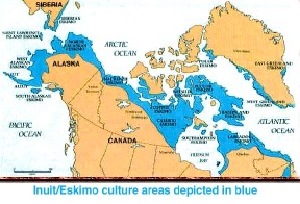
Origins of the Alaskan
Malamute
The Alaskan Malamute shares a common
heritage with native arctic dogs found along the north western shores of
Alaska, through the interior of Alaska and Canadian Yukon territories,
and across the circumpolar regions including the far eastern Inuit
communities of Baffin Island and Greenland.
They are
descendants of domesticated wolf-dogs who accompanied bands of nomadic
Paleolithic hunters from Mongolia across Siberia, eastward over the
land bridges of the Bering Strait and into the North American continent
in a series of migrations some four thousand years ago. These nomadic
hunters were later called Eskimo or Inuit.
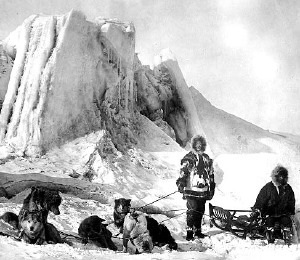
Inupiaq Eskimos near the Bering Sea
The Inuit in Alaska and Canada
These small nomadic bands were comprised of extended families
with a communal division of labor and shared resources. As the
population expanded, groups splintered off in search of new fishing and
hunting grounds.
Over the years these ancestral Inuit (also
known regionally as Yupik and Inupiaq Eskimo) departed from their home
land along the northeast coast of Alaska's Seward peninsula. Some
wandered south and settled in the vicinity of Nome and the Norton Sound;
others migrated east along Canada's northernmost lands.
Despite the widespread dispersal of Eskimo/Inuit peoples, they share a
strong cultural identity and speak closely related dialects.
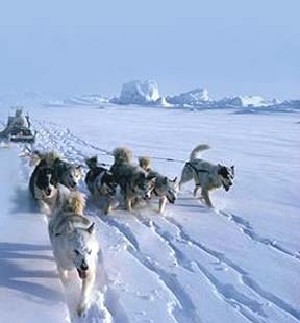
An Inuit Sled Dog team (courtesy G. Pelletier)
The Role of
Arctic Dogs in Inuit Communities
The 'generic' northern dogs, ancestors of today's Alaskan Malamutes,
Canadian Eskimo Dogs, and Inuit Sled Dogs, played a pivotal role in the
subsistence-based communities throughout the circumpolar region. Dogs
accompanied the Inuit onto ice floes during the winter and assisted
during the hunt: sniffing out seal holes in the ice and holding polar
bears at bay. They hauled the butchered carcasses of seals and whale
back to camp. Dogs were the guardians of the seasonal encampments,
alerting residents to marauding bears and other intruders.
When native populations migrated inland during the summer and fall in
pursuit of caribou and moose, the dogs were used in tracking large game
and as pack animals, carrying the families' few possessions between
camps. Teams of native dogs were harnessed and used on trap lines when
the fur trade gained ascendancy throughout the far north. From guard dog
to sled dog, they were indispensable to the survival of the Inuit people.
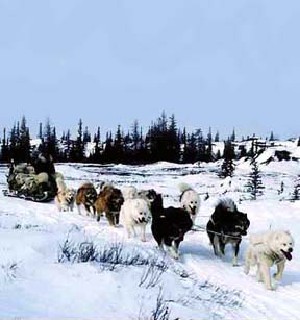
Canadian Eskimo Dogs (source: J. Kelly)
Characteristics of the Native Arctic Dogs
These
northern dogs belong to the Spitz family (which includes the Chow, Samoyed,
and Norwegian Elkhound); all of which have a weatherproof double
coat, large furred feet, well muscled compact bodies, wedge-shaped head
with small prick ears and a bushy tail carried over the back.
Found in a rainbow of colors-- grays, blacks, reds, browns, and even
solid whites-- these dogs also exhibit some variation in size.
Canadian Eskimo Dogs (CED) and Inuit Sled Dogs (ISD) range in height
from a small 20 inch female to a large 28 inch male, with weights ranging
from 65 to 85 lbs for males and 40-65 pounds for females, while Alaskan
Malamutes are generally 23-26 inches, 70-90 pounds.
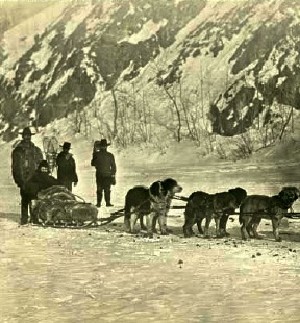
Gold Rush Dog team near Nome 1910
The Gold Rush
During the Gold Rush
in the late 1800s native sled dogs were used to haul freight, supplies,
and deliver mail to mining communities in winter when boats could no
longer navigate the frozen tributaries. The demand for freighting teams
was so high that thousands of dogs--St. Bernards, Mastiffs and other
large breeds--were shipped north from Seattle.
As a result of
this influx, native dogs with little immunity succumbed to diseases
spread by the new imports; others became extinct by genetic swamping, the
result of crossbreeding with dogs from the 'lower 48.' Some breed
historians believe the excessive size seen in today's Malamute "Giant"
lines can be attributed to this impure breeding with St. Bernards and
Mastiffs during the Goldrush era.
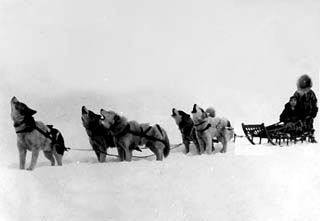
A Malamute Team Howling, Nome 1910
Preserving the Native Arctic Breeds
In arctic communities at some
distance from the Gold Rush boom towns, small populations of
native sled dogs survived despite the
encroachment of outside influences. Efforts to preserve these indigenous
dogs led to the establishment of three closely related breeds
known today the Canadian Eskimo Dog, the Inuit Sled Dog, and the Alaskan
Malamute.
Careful selection by dedicated Malamute fanciers
restored the correct original type and most of today's AKC Alaskan
Malamutes are excellent representative of the true native sled dog of the
North.
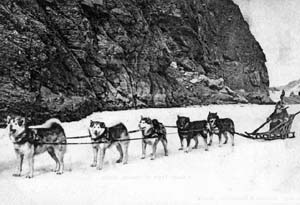
An Alaskan Malamute Team 1906
Establishing the AKC Alaskan Malamute
The Alaskan Malamute was created as a distinct
breed in the 1930s by Short Seely when she selected a few exemplary
dogs to serve as the foundation of her Kotzebue line as well as the
beginning of a new AKC registered breed. The dogs she chose tended to be
mostly gray & whites and similar in size to other native sled dogs.
The 1935 AKC standard reflected this: Males were described as
22-25 inches 65-85 lbs; Females 20-23 inches, 50-70 lbs. Seely's creation
(or recreation) of the breed was based on descriptions of what the native
arctic sled dogs looked like before the Alaska Goldrush in the 1890s.
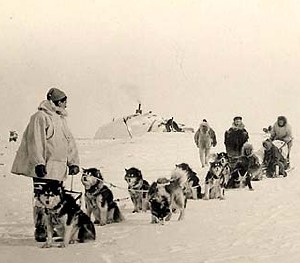
Alaskan Malamute team--1950s
Adding the M'Loots
Subsequently in the 1950s, a second strain of Malamute dogs exhibiting a
greater variety of colors and sizes was added to the AKC breed registry.
These were known as M'loots and like the Kotzebue foundation dogs, these
Arctic sled dogs had been used as freighting dogs, for work on traplines
and for hunting in native Alaskan communities. While a couple of these
dogs were extremely large, for example, Geronimo owned by Robert Zoller
of Husky-Pak Kennels was 27 inches tall, 115 lbs, most of the M'loots
were moderate in size around 24-25 inches tall. (If you research the
breed history books and the pedigree journals, none of these early
M'loots approached the exaggerated size of today's 190 pound "Giant"
Malamutes.)
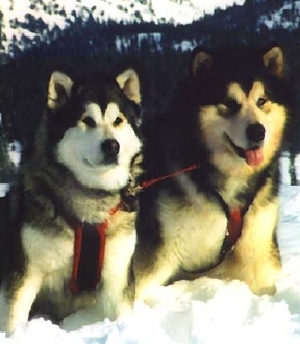
(L) Our 75% M'Loot foundation bitch
Ch Snowlion's Kali Devi
The AKC Alaskan Malamute Today
In 1960 the AKC standard was
revised to reflect the M'loot contributions to the breed and the upper
size range of the first standard--23 inches, 75 lbs for females and 25 inches, 85 lbs for
males--was now listed as the preferred size.
Deliberate crossbreedings between Kotzebue and M'Loot improved the appearance,
balance and overall quality of the breed. These crosses (which were superior to the original pure Kotzebue and M'loot dogs) are behind the
majority of today's malamute kennels.

